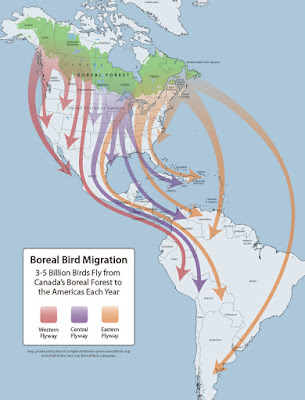Joey (in Chicago):
Interesting questions that you pose.
First, migration is different than dispersal.
Dispersal is post-nesting behavior when birds remain in the area where they bred, but have not yet migrated. Foraging is the principal activity, say, in July or August for these birds. Molting may be included as a post-breeding phenomenon for some dispersing individuals.
Migrating is moving with purpose to non-breeding grounds away from where birds spent the breeding season. Hence, true northern hemisphere neotropical migrant bird species migrate after breeding to non-breeding grounds before again looping back north again the following spring.
Seeking even more details about this subject? Please read below at the * area.
(* = Dispersal begins earlier than migration. Fledgings leave the nest and begin their independent lives while foraging BEFORE eventually migrating. So newborns may linger in an area near where they were born. By mid- to late-August at upper Midwest latitudes, some begin to migrate south while other species -- such as American Redstart, Palm Warbler, Yellow-rumped Warbler, among others — may have a protracted migration. These three species are among the latest to leave northern latitudes, with some Yellow-rumped and Palm remaining through November and December -- and, in recent years, some of both species persisting through Christmas Bird Count surveys in the upper Midwest (and even remaining throughout the winter in some cases). Pine Warbler may also persist late while sometimes feeding at seed feeders after an insect fauna is depleted with freezing temperatures.)
Now, let's discuss breeding vs. non-breeding ranges of wood-warbler species.
A nice resource to read about breeding vs. non-breeding ground ranges of wood-warblers is in Warblers (the field guide from 1998 by Jon Dunn and Kimball Garrett). Its information is dated in spots, but most of the text remains valid. As a more updated complement, I also refer to the fantastic The Warbler Guide (Tom Stephenson and Scott Whittle, Princeton University Press, 2013). This guide's range maps for migration and breeding/non-breeding ranges more accurate in some cases than Warblers, with more comprehensive photos for each species. You won't be sorry for purchasing both books.
Now, here's an illuminating example that incorporates the above information.
It's a past report from Ryan Brady, an ornithologist/bird researcher/scientist for the Wisconsin DNR. His late summer list of is below. See his list of 20 wood-warbler species that he noticed on 8/29/17 near Bayfield/Washburn, WI (near Lake Superior): (Then see more of my commentary, below.)
From: Ryan Brady <ryanbrady10@hotmail.com>
Subject: [wisb] 20 warbler sp. - Bayfield County
Date: Wed, 30 Aug 2017 01:50:37 +0000
An excellent flight last night brought 20 species of warblers to the trails around my property this morning, including Golden-winged, Blackpolls, Bay-breasteds, Mournings, Palms, Pine, and more. Thrushes were on the move in the morning fog, yielding some Swainson's and my first Gray-cheekeds of the fall. Also had my first Lincoln's Sparrow and a nice push of 3 Yellow-bellied Flycatchers.
Full eBird checklist at http://ebird.org/ebird/wi/view/checklist/S38887593
Ryan Brady
Washburn, Bayfield County, WI
http://www.pbase.com/rbrady
I hope these answer your questions, Joey?
In closing:
It's time for the D & M Show, so to speak (Dispersal & Migration Show.....(!) ).
Enjoy the birding, everyone....
Regards, Daniel
warblerwatch.com (hosts my "Birding Tours" that I have led as a Birding Guide since the 1980s
Got wood-warbler questions? If so, I have answers for you. I'm Daniel Edelstein — biologist, birding guide, birding instructor (www.warblerwatch.com and danieledelstein@att.net) — who ponders: Are there any wonders in our world more fascinating than the elegant beauty of wood-warblers? (All photos © Martin Meyers unless otherwise noted.) By the way, my upcoming new adult college birding class is featured at: http://danielsmerrittclasses.blogspot.com/
Tuesday, July 23, 2019
Wednesday, July 10, 2019
Warbler Guy, where are warbler photos best found on the Web? Where may I compare and contrast warbler images online?
Jason (in Buffalo), I recommend the web site operated by Giff Beaton in Georgia.
Giff's "Warblers" site is found at:
http://www.giffbeaton.com/warblers.htm
(male Magnolia Warbler, below)
(male Magnolia Warbler, below)
Recent systematic name changes in the warbler family are also present in the way Giff organizes his photos, so information is updated according to the latest American Ornithological Union (AOU) decisions.
His site also features links to bird-related sites; information and photos related to dragonflies and insects; and links to other nature topics (See: http://www.giffbeaton.com/index.html)
Subscribe to:
Comments (Atom)

